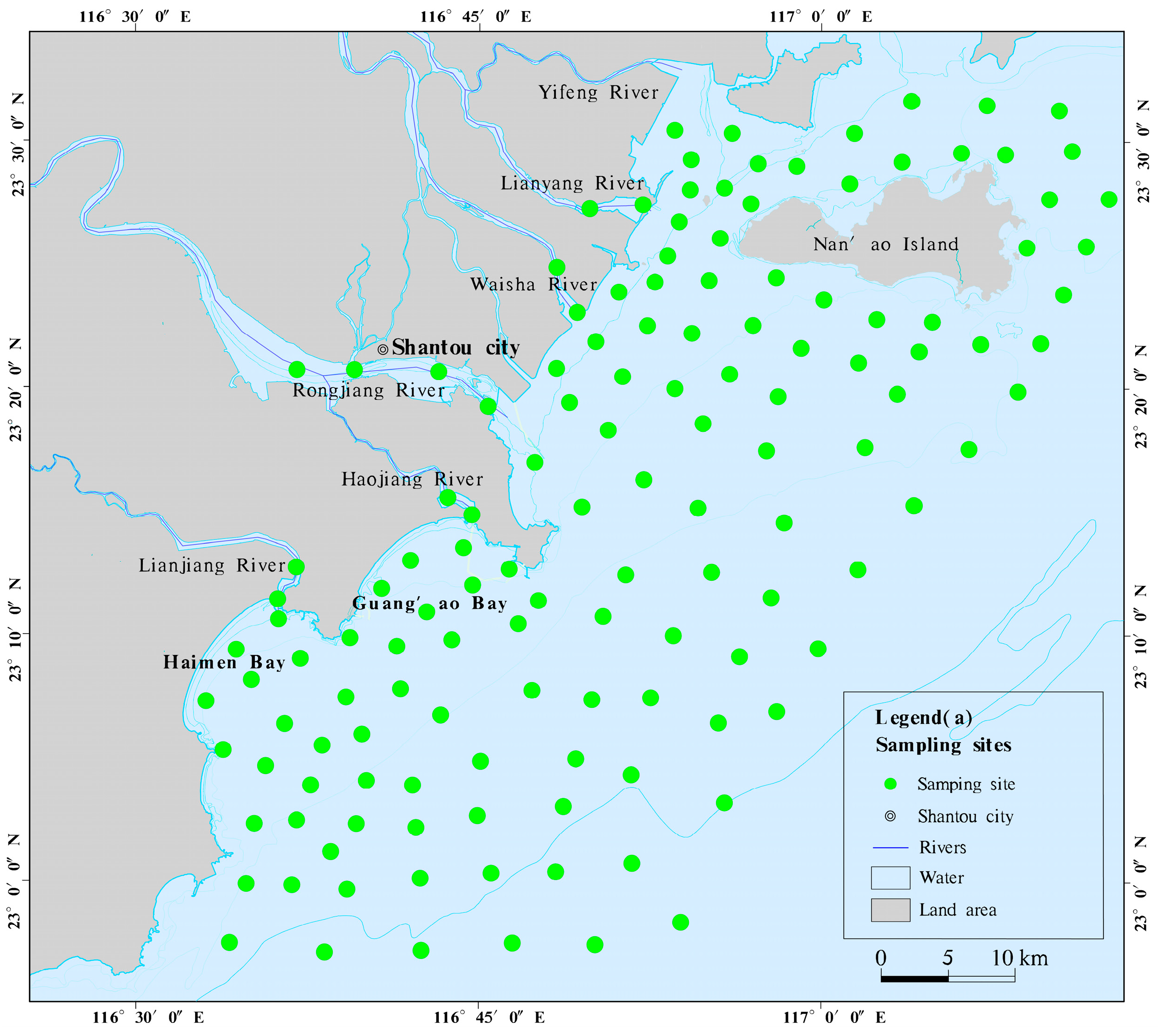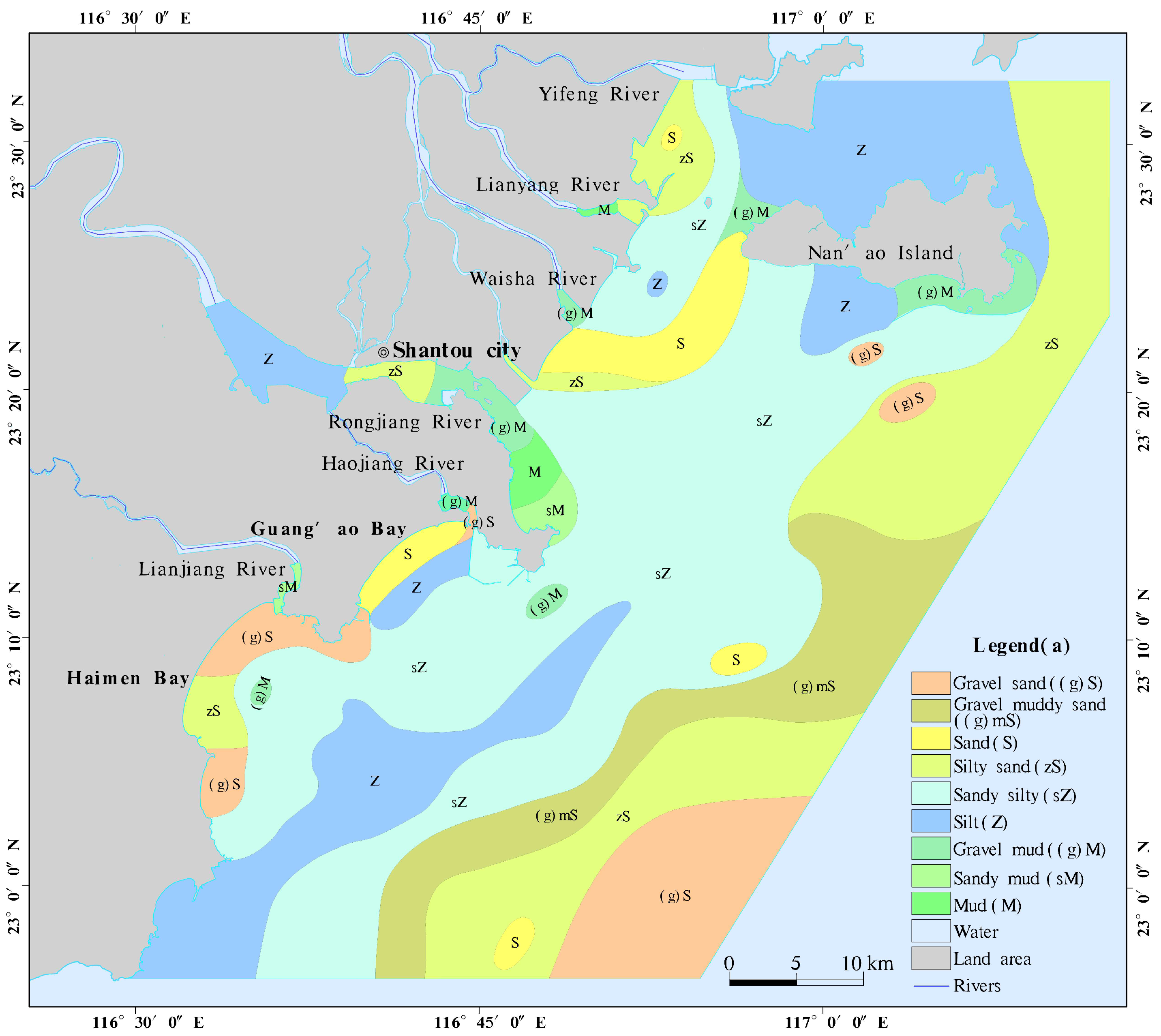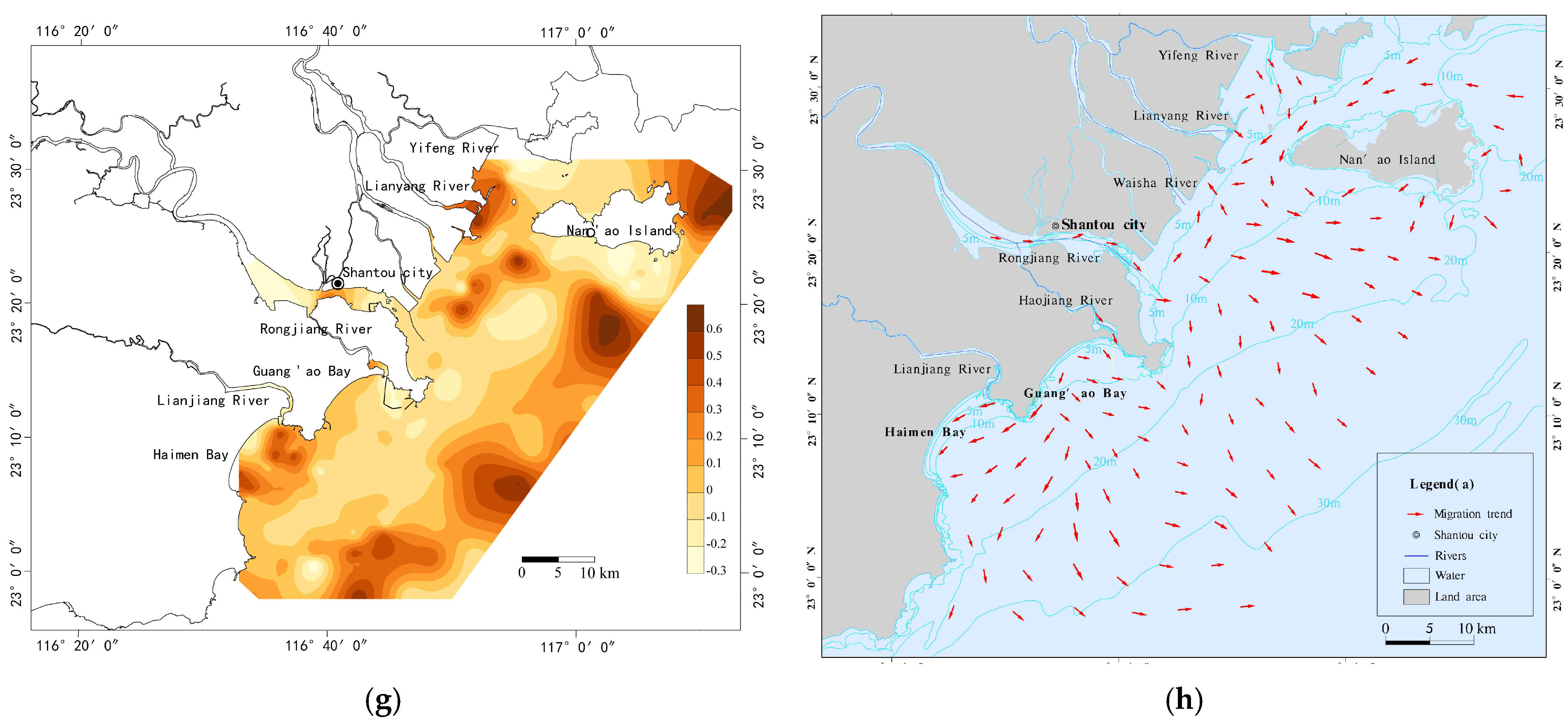Grain Size Characteristics of Surface Sediments and Their Migration Trends in the Nearshore Waters of East Guangdong
Abstract
:1. Introduction
2. Materials and Methods
3. Results
3.1. Main Sediment Types and Distribution Characteristics
3.2. Grain Size Component Characteristics
3.2.1. Gravel Grain Level Component
3.2.2. Sand Grain Level Component
3.2.3. Silt Grain Level Component
3.2.4. Clay Grain Level Component
3.3. Grain Size Parameter Characteristics
3.3.1. Mean Grain Size Distribution Characteristics
3.3.2. Distribution Characteristics of Sorting Coefficient
3.3.3. Skewness Distribution Characteristics
3.4. Analysis of Surface Sediment Migration Trends
4. Discussion
4.1. Climatic Factors
4.2. Ocean Dynamical Factors
4.3. River Dynamic Factors
4.4. Geomorphological Factors
4.5. Geological Factors
5. Conclusions
- (1)
- The sediment types in the study area are mainly gravel sand ((g)S), gravel muddy sand ((g)mS), gravelly mud ((g)M), sand (S), silty sand (zS), sandy silt (sZ) and silt (Z), and a small amount of sandy mud (sM) and mud (M). The relative percentages of gravel, sand, silt and mud were 0.7%, 40.56%, 46.7% and 12.04%, respectively. The average grain size varied between approximately −2φ and 8φ, with a mean value of 4.94φ. The selection coefficient varied between 0.44~3.78, with a mean value of 1.8. The skew distribution ranged from −0.34 to 0.67, with a mean value of 0.07.
- (2)
- There are two main factors influencing the distribution of sediment in the research area. On one hand, there are external driving forces that play a dominant, active and influential role, including climate factors (temperature, precipitation and wind), ocean dynamics (tides, currents, and waves) and river dynamics. On the other hand, there are internal driving forces, including geomorphic and geological factors, which exert constraining effects as relatively static and indirect factors.
- (3)
- The trend of surface sediment transport is significant, and the north side of Nan’ao Island is oriented from east to west. The sediment of the Yifeng River is mainly deposited in the sand spout at the mouth of the Lianyang River. After being transported southward from Houjiang Waterway, it mainly migrates to the southeast, and the trend is quite significant until the trend gradually decreases at the 20 m isobath. The sediment of the Rong River is mainly deposited outside the mouth of Niutian Yang and Rong River, and the surface sediment of Guang’ao Bay and Haimen Bay is oriented from northwest to southeast. After the 30 m isobath, the southeast corner of the study area migrates in a southeast–south direction.
- (4)
- The sediment transport pattern expressed by the grain size migration trend is in good agreement with the hydrodynamic conditions of the study area, which confirms the previous studies on sediment transport and sources in the area. It can provide a basis and reference for decisions regarding channel dredging, wharf site selection, port construction and mariculture in the area. For example, in terms of channel dredging, it is necessary to clean not only the navigational channel but also the heavily silted areas around the channel (such as the northeast side of the Rongjiang estuary and both sides of the sand barrier). When selecting a location for a dock, areas of sediment accumulation should be avoided, such as the cape on the north side of Haimen Bay; the northeast and southeast sides of Nan’ao Island would be better options.
Author Contributions
Funding
Institutional Review Board Statement
Informed Consent Statement
Data Availability Statement
Conflicts of Interest
References
- Jiang, M. Grain size analysis and geological application. J. Oil Gas Technol. 2009, 31, 161–163. [Google Scholar]
- Xiao, C.; Li, Z. The research summary of grain size analysis and its application in the sedimentation. J. Xinjiang Norm. Univ. Nat. Ed. 2006, 3, 118–123. [Google Scholar]
- Shi, X. Basic parameters and research process of marine sedimentary environment. Mar. Sci. 1992, 6, 30–33. [Google Scholar]
- Rodriguez, A.B.; Rodriguez, P.L.; Fegley, S.R. One-year along-beach variation in the maximum depth of erosion resulting from irregular shoreline morphology. Marine Geol. 2012, 291–294, 12–23. [Google Scholar] [CrossRef]
- Warrick, J.A.; George, D.A.; Gelfenbaum, G.; Ruggiero, P.; Kaminsky, G.M.; Beirne, M. Beach morphology and change along the mixed grain-size delta of the dammed Elwha River, Washington. Geomorphology 2009, 111, 136–148. [Google Scholar] [CrossRef]
- Vousdoukas, M.; Velegrakis, A.; Karambas, T. Morphology and sedimentology of a microtidal beach with beachrocks: Vatera, Lesbos, NE Mediterranean. Cont. Shelf Res. 2009, 29, 1937–1947. [Google Scholar] [CrossRef]
- Yuan, P.; Bi, N.; Wu, X.; Zhang, Y.; Wang, H. Spatial distribution characteristics of modern Yellow River Delta surface sediments. Marine Geol. Quatern. Geol. 2016, 36, 49–57. [Google Scholar]
- Liu, J.; Li, A.; Xu, Z. Grain size characteristics of sediments in Bohai Bay since the Holocene. Mar. Sci. 2006, 30, 60–65. [Google Scholar]
- Yang, X.; Feng, X.; Chu, Z.; Fan, D.; Dong, A. Grain size characteristics of surface sediments and their depositional environment on the eastern shelf of China. J. Ocean Univ. China Nat. Sci. Ed. 2012, 42, 126–134. [Google Scholar]
- Liu, Q.; Xiang, L.; Zhang, G.; Ouyang, K. Characteristics of surface sediment distribution and its controlling factors in the abandoned Yellow River estuary in northern Jiangsu Province. Mar. Geol. Quat. Geol. 2018, 38, 118–126. [Google Scholar]
- Feng, L.; Feng, X.; Song, S.; Xiao, X.; Tian, D. Analysis of particle size and distribution characteristics of surface sediments and the transport trend in Laizhou Bay. Mar. Sci. 2018, 42, 1–9. [Google Scholar]
- Li, P.; Huang, Z.; Zong, Y.; Zhang, Z. Hanjiang Delta; Ocean Publishing House: Beijing, China, 1987. [Google Scholar]
- Ge, Q.; Xue, Z.G.; Ye, L.; Xu, D.; Yao, Z.; Chu, F. Distribution Patterns of Major and Trace Elements and Provenance of Surface Sediments on the Continental Shelf off Western Guangdong Province and Northeastern Hainan Island. J. Ocean Univ. China 2019, 18, 849–858. [Google Scholar] [CrossRef]
- Hou, Y.S.; Wu, J.C.; Jiang, J.G. Time Behavior of Anomalous Solute Transport in Three-Dimensional Cemented Porous Media. Soil Sci. Soc. Am. J. 2019, 83, 1012–1023. [Google Scholar] [CrossRef]
- Ma, Z.; Dai, Z.; Zhang, X.; Zhan, C.; Gong, H.; Zhu, L.; Wallace, C.D.; Soltanian, M.R. Dispersivity variations of solute transport in heterogeneous sediments: Numerical and experimental study. Stoch. Environ. Res. Risk Assess. 2021, 36, 661–677. [Google Scholar] [CrossRef]
- Li, P.; Huang, Z.; Zong, Y. The Han River Delta; Ocean Press: Beijing, China, 1987. [Google Scholar]
- Wang, H.; Wang, Y.; Wang, H.; Luo, X.; Mai, Y.; Huang, X.; Wang, Z. Progress of research on barrier sedimentation system and prospects of barrier island research in China. J. Shantou Univ. Nat. Sci. Ed. 2022, 37, 3–12+2. [Google Scholar]
- Yan, X.; Liu, G.; Cai, J. Characterization of coastal dynamic geomorphology of coal port project of Chaozhou Three Hundred Gate Power Plant. Waterw. Port 2004, 25, 38–44. [Google Scholar]
- Wu, T.; Chen, R.; Wu, X.; Dong, Z. Experimental study on the tidal sediment model of Han River estuary management planning scheme. People’s Pearl River 2007, 28, 35–38. [Google Scholar]
- Chen, H.; Chen, Z.; Yan, W.; Li, L.; Liu, J.; Huang, W.; Li, G. Grain size characteristics of surface sediments and their migration trends in Shantou nearshore waters. J. Sedimentol. 2014, 32, 314–324. [Google Scholar]
- Do Minh Duc, M.T.N.; Van Ngoi, C.; Nghi, T.; Tien, D.M.; van Weering, T.C.; van den Bergh, G.D. Sediment distribution and transport at the nearshore zone of the Red River delta, Northern Vietnam. J. Asian Earth Sci. 2007, 29, 558–565. [Google Scholar]
- Ogston, A.S.; Sternberg, R.W.; Nittrouer, C.A.; Martin, D.P.; Goñi, M.A.; Crockett, J.S. Sediment delivery from the Fly River tidally dominated delta to the nearshore marine environment and the impact of El Niño. J. Geophys. Res. Atmos. 2008, 113, F01S11. [Google Scholar] [CrossRef] [Green Version]
- Burchard, H.; Schuttelaars, H.M.; Ralston, D.K. Sediment trapping in estuaries. Annu. Rev. Mar. Sci. 2018, 10, 371–395. [Google Scholar] [CrossRef] [PubMed]
- Huang, L.; Shen, P.; Liu, C.; Tan, Y. General Report on the Comprehensive Survey and Evaluation of the Offshore Ocean of Guangdong Province; Ocean Press: Beijing, China, 2017. [Google Scholar]
- Folk, R.L.; Ward, W.C. Brazos River bar: A study in the significance of grain size parameters. J. Sediment. Petrol. 1957, 27, 3–26. [Google Scholar] [CrossRef]
- GB/T 12763.8-2007; Marine Survey Specification Part 8: Marine Geological Geophysical Survey. General Administration of Quality Supervision, Inspection and Quarantine of the People’s Republic of China: Beijing, China, 2007; pp. 1–79.
- Yang, S. Statistic features for grain-size parameters of the Yangze River Estuary and their hydrodynamic explanation. J. Sediment Res. 1994, 3, 23–31. [Google Scholar]
- Wu, A. The characteristics of grain-size parameters of till and their relation to sedimentary environments. J. Glaciol. Geocryol. 1983, 5, 47–53. [Google Scholar]
- McLaren, P. An Interpretation of Trends in Grain Size Measures. J. Sediment. Res. 1981, 51, 611–624. [Google Scholar]
- McLaren, P.; Bowles, D. The effects of sediment transport on grain-size distributions. J. Sediment. Res. 1985, 55, 457–470. [Google Scholar]
- Shu, G.; Collins, M. The use of grain size trends in marine sediment dynamics: A review. Chin. J. Oceanol. Limnol. 2001, 19, 265–271. [Google Scholar] [CrossRef]
- Gao, S. Grainsize trend analysis: Principle and applicability. ACTA Sedimentol. Sin. 2009, 5, 826–836. [Google Scholar]
- Chen, Z. Characteristics of modern sedimentary environment and sediment transport patterns in Shuidongbay, western Guangdong. Tropic Oceanol. 1996, 15, 6–13. [Google Scholar]
- Ren, J.; Liu, P.; Dai, Z. Characteristics of bottom sediment and sediment transport patterns in Hailing bay, western Guangdong. J. Oceanogr. Taiwan Strait 2001, 20, 96–100. [Google Scholar]
- Cheng, P.; Gao, S. Net sediment transport patterns over the northwestern Yellow Sea, based upon grain size trend analysis. Oceanol. Limnol. Sin. 2000, 31, 604–615. [Google Scholar]
- Liu, Z.; Yang, Y.; Chen, J.; Wang, A.J.; Li, D.Y.; Wang, Y.P. Sediment distribution and deposition rate in the Xiamen Bay and adjoining waters. Mar. Sci. 2012, 36, 1–8. [Google Scholar]
- Jia, Y.; Ke, X.; Xu, Y.; Wang, Y. Sedimentary transport trends of within a sand Bar/Lagoon system in the Bohaisea. Mar. Sci. 1999, 3, 56–59. [Google Scholar]
- Cheng, P.; Gao, S.; Bokuniewicz, H. Net sediment transport patterns over the Bohai Strait based on grain size trend analysis. Estuar. Coast. Shelf Sci. 2004, 60, 203–212. [Google Scholar] [CrossRef]
- Balsinha, M.; Fernandes, C.; Oliveira, A.; Rodrigues, A.; Taborda, R. Sediment transport patterns on the Estremadura Spur continental shelf: Enlightenment of particle size trend analysis. J. Sea Res. 2014, 93, 28–32. [Google Scholar] [CrossRef]
- Liang, J.; Liu, J.; Xu, G.; Chen, B. Grain-size characteristics and net transport patterns of surface sediments in the Zhejiang nearshore area, East China Sea. Oceanologia 2020, 62, 12–22. [Google Scholar] [CrossRef]
- Wang, C.; Chen, M.; Qi, H.; Intasen, W.; Kanchanapant, A. Grain-Size Distribution of Surface Sediments in the Chanthaburi Coast, Thailand and Implications for the Sedimentary Dynamic Environment. J. Mar. Sci. Eng. 2020, 8, 242. [Google Scholar] [CrossRef] [Green Version]
- Liu, J.T.; Liu, K.J.; Huang, J.C. The effect of a submarine canyon on the river sediment dispersal, and inner shelf sediment movements in southern Taiwan. Mar. Geol. 2002, 181, 357–386. [Google Scholar] [CrossRef]
- Gao, S.; Collins, M. Sediment grain size trends and marine sediment dynamics. China Sci. Found. 1998, 4, 1. [Google Scholar]
- Shepard, F.P. Nomenclature Based on Sand-silt-clay Ratios. J. Sediment. Res. 1954, 24, 151–158. [Google Scholar]
- Folk, R.L.; Andrews, P.B.; Lewis, D.W. Detrital sedimentary rock classification and nomenclature for use in New Zealand. N. Z. J. Geol. Geophys. 1970, 13, 937–968. [Google Scholar] [CrossRef] [Green Version]
- Liu, Z. Clay minerals in sediment of the South China Sea: Indications of East Asian monsoon evolution history? Acta Sedimentol. Sin. 2010, 28, 1012–1019. [Google Scholar]




| Sediment Type | Characteristic Value | Grain Size Composition% | Grain Size Parameter | |||||
|---|---|---|---|---|---|---|---|---|
| Gravel | Sand | Powder Sand | Clay | Mean Particle Diameter (Mz) | Sorting Coefficient (σi) | Skewness (Ski) | ||
| Gravel sand | Min | 0.14 | 99.86 | 0.00 | 0.00 | 1.14 | 0.80 | −0.01 |
| Max | 4.22 | 95.78 | 0.00 | 0.00 | 1.09 | 1.01 | −0.23 | |
| Average | 1.49 | 93.24 | 5.23 | 0.02 | 1.82 | 1.47 | 0.00 | |
| Gravel muddy sand | Min | 0.26 | 69.03 | 26.94 | 3.77 | 3.59 | 2.69 | 0.61 |
| Max | 1.99 | 49.98 | 43.82 | 4.22 | 4.49 | 1.13 | 0.04 | |
| Average | 1.04 | 64.48 | 30.80 | 3.65 | 3.43 | 1.97 | 0.38 | |
| Gravelly mud | Min | 0.05 | 28.00 | 39.10 | 32.85 | 6.53 | 0.86 | −0.16 |
| Max | 0.13 | 10.78 | 74.55 | 14.54 | 6.60 | 1.55 | −0.34 | |
| Average | 0.83 | 22.79 | 57.77 | 18.60 | 6.02 | 2.14 | 0.09 | |
| Sand | Min | 0.00 | 91.25 | 7.44 | 1.31 | 2.28 | 1.15 | 0.35 |
| Max | 0.00 | 100.00 | 0.00 | 0.00 | 1.96 | 0.47 | 0.03 | |
| Average | 0.00 | 98.90 | 0.92 | 0.10 | 2.03 | 0.62 | 0.02 | |
| Silty sand | Min | 0.00 | 51.91 | 42.67 | 5.42 | 4.20 | 2.37 | 0.36 |
| Max | 0.00 | 89.75 | 10.25 | 0.00 | 2.56 | 0.45 | 0.27 | |
| Average | 0.00 | 66.05 | 28.56 | 5.42 | 3.66 | 2.03 | 0.48 | |
| Sandy silt | Min | 0.00 | 10.00 | 63.34 | 26.65 | 6.76 | 1.93 | −0.128 |
| Max | 0.00 | 48.04 | 46.08 | 5.86 | 4.46 | 2.39 | 0.11 | |
| Average | 0.00 | 25.84 | 60.18 | 13.94 | 5.68 | 2.00 | 0.01 | |
| Silt | Min | 0.00 | 2.01 | 74.78 | 23.21 | 7.04 | 1.40 | −0.008 |
| Max | 0.00 | 9.98 | 64.95 | 25.07 | 6.68 | 2.18 | 0.04 | |
| Average | 0.00 | 6.12 | 73.72 | 20.15 | 6.73 | 1.59 | 0.00 | |
| Sandy mud | Min | 0.00 | 12.34 | 56.90 | 30.76 | 6.92 | 2.48 | 0.06 |
| Max | 0.00 | 30.46 | 38.58 | 30.96 | 6.40 | 3.22 | −0.08 | |
| Average | 0.00 | 20.69 | 48.47 | 30.82 | 6.65 | 2.82 | 0.07 | |
| Mud | Min | 0.00 | 3.97 | 51.08 | 44.95 | 7.30 | 0.44 | −0.04 |
| Max | 0.00 | 4.87 | 62.08 | 33.05 | 7.51 | 2.17 | 0.12 | |
| Average | 0.00 | 4.42 | 56.58 | 39.00 | 7.40 | 1.30 | 0.04 | |
| Sorting Grade | Sorting Coefficient (φi) |
|---|---|
| Sorting excellent | <0.35 |
| Sorting good | 0.35~0.71 |
| Sorting medium | 0.71~1.00 |
| Sorting poor | 1.00~4.00 |
| Sorting very poor | >4.00 |
| Skewness Grading | Skewness (Ski) |
|---|---|
| Extremely negative bias | −1~−0.3 |
| Negative skew | −0.3~−0.1 |
| Nearly symmetric | −0.1~+0.1 |
| Positive skew | +0.1~+0.3 |
| Extremely positive bias | +0.3~+1 |
| Grain Size Trend Type | Definition | ||
|---|---|---|---|
| 1 | σA < σB | μA < μB | SkA > SkB |
| 2 | σA < σB | μA > μB | SkA < SkB |
| Month | January | February | March | April | May | June | July | August | September | October | November | December | Year |
|---|---|---|---|---|---|---|---|---|---|---|---|---|---|
| Average wind speed | 2.9 | 3.1 | 3.0 | 2.6 | 2.5 | 2.5 | 2.6 | 2.3 | 2.6 | 2.8 | 2.9 | 2.8 | 2.7 |
| Predominant wind direction for each month | ENE | ENE | ENE | ENE | ENE | SSW | SSW | ESE | ENE | ENE | ENE | ENE | ENE |
| Frequency | 20 | 26 | 26 | 21 | 17 | 11 | 10 | 10 | 14 | 24 | 23 | 21 | 18 |
Disclaimer/Publisher’s Note: The statements, opinions and data contained in all publications are solely those of the individual author(s) and contributor(s) and not of MDPI and/or the editor(s). MDPI and/or the editor(s) disclaim responsibility for any injury to people or property resulting from any ideas, methods, instructions or products referred to in the content. |
© 2023 by the authors. Licensee MDPI, Basel, Switzerland. This article is an open access article distributed under the terms and conditions of the Creative Commons Attribution (CC BY) license (https://creativecommons.org/licenses/by/4.0/).
Share and Cite
Wang, H.; Wu, Y.; Wan, X.; Xia, L.; Wang, S. Grain Size Characteristics of Surface Sediments and Their Migration Trends in the Nearshore Waters of East Guangdong. Sustainability 2023, 15, 11069. https://doi.org/10.3390/su151411069
Wang H, Wu Y, Wan X, Xia L, Wang S. Grain Size Characteristics of Surface Sediments and Their Migration Trends in the Nearshore Waters of East Guangdong. Sustainability. 2023; 15(14):11069. https://doi.org/10.3390/su151411069
Chicago/Turabian StyleWang, Hongbing, Yuxi Wu, Xiaoming Wan, Lu Xia, and Si Wang. 2023. "Grain Size Characteristics of Surface Sediments and Their Migration Trends in the Nearshore Waters of East Guangdong" Sustainability 15, no. 14: 11069. https://doi.org/10.3390/su151411069
APA StyleWang, H., Wu, Y., Wan, X., Xia, L., & Wang, S. (2023). Grain Size Characteristics of Surface Sediments and Their Migration Trends in the Nearshore Waters of East Guangdong. Sustainability, 15(14), 11069. https://doi.org/10.3390/su151411069










